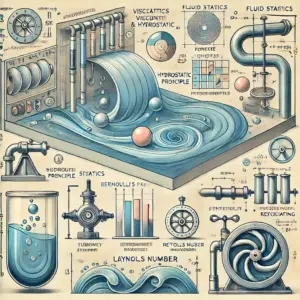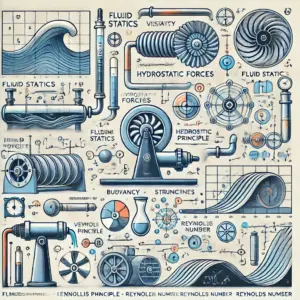FMM Notes Pdf | Fluid Mechanics and Machinery JNTU Free Lecture Notes Download
Here you can download the free lecture Notes of Fluid Mechanics and Machinery Notes Pdf – FMM Pdf Notes materials with multiple file links to download. The Fluid Mechanics and Machinery Notes Pdf – FMM Notes Pdf book starts with topics covering fluid mechanics, fluid kinematics, Flow through circular conducts, Dimensional and model analysis, boundary layer concept, detection and prevention of cavitation, Etc.

Fluid Mechanics and Machinery Notes
The Fluid Mechanics and Machinery Notes pdf – FMM notes pdf file
Fluid Mechanics and Machinery Notes pdf – FMM pdf notes – FMM notes pdf file to download are listed below please check it –
Complete Notes
Unit 1
Unit 2
Unit 3
Unit 4
Unit 5
Note :- These notes are according to the R09 Syllabus book of JNTU.In R13 and R15,8-units of R09 syllabus are combined into 5-units in R13 and R15 syllabus. If you have any doubts please refer to the JNTU Syllabus Book.
Fluid Mechanics and Machinery Pdf Notes – FMM Pdf Notes Free Download
Fluid Mechanics and Machinery is a fundamental course in mechanical engineering that deals with the behavior of fluids (liquids and gases) at rest and in motion. It covers various principles and applications, including fluid properties, fluid dynamics, flow through pipes, dimensional analysis, and the operation of hydraulic machines. These notes are aligned with the JNTU syllabus and provide comprehensive coverage of the subject matter, making them essential for B.Tech students aiming to understand fluid behavior and machinery operation.
Fluid Mechanics and Machinery | PDF, Syllabus, Books | B Tech (2025)
Overview
Fluid Mechanics and Machinery is a critical area of study that explores the principles governing fluid behavior and the design of machinery that utilizes these principles. This subject covers topics such as fluid properties, flow dynamics, boundary layers, cavitation, and hydraulic machines. The notes are structured according to the JNTU syllabus, offering students a detailed understanding of fluid mechanics concepts and applications.
The notes are divided into five units, following the JNTU curriculum, to provide a thorough exploration of fluid mechanics and machinery topics.
The following topics are covered in Fluid Mechanics and Machinery Handwritten Notes
Unit 1: Properties of Fluids and Fluid Mechanics
- Properties of Fluids:
Understanding fluid properties is essential for analyzing fluid behavior. This section covers key properties such as density, specific weight, specific volume, specific gravity, viscosity, and surface tension. - Fluid Mechanics and Dynamics:
Fluid mechanics involves the study of fluids in motion and at rest. This topic covers fluid dynamics principles, including the continuity equation and Bernoulli’s equation, and their applications in engineering. - Fluid Kinematics:
Fluid kinematics focuses on describing the motion of fluids without considering the forces causing the motion. This section explores the Lagrangian and Eulerian methods for analyzing fluid flow.
Unit 2: Flow Through Pipes
- Flow Through Circular Conducts:
This section covers the analysis of fluid flow through pipes, including laminar and turbulent flow. It explores factors affecting flow, such as pipe diameter, flow velocity, and pressure drop. - Energy Losses in Pipes:
Energy losses in pipes occur due to friction and turbulence. This topic covers major and minor energy losses, and equations used to calculate them, such as Darcy’s and Chezy’s formulas. - Boundary Layer Flow:
The boundary layer is a thin layer of fluid near a solid surface where viscous effects are significant. This section explores the concepts of laminar and turbulent boundary layers, and the use of the Moody diagram for analysis.
Unit 3: Dimensional and Model Analysis
- Dimensional Analysis:
Dimensional analysis is a mathematical technique used to simplify complex fluid mechanics problems. This section covers the principles of dimensional homogeneity and methods such as Rayleigh’s and Buckingham’s theorem. - Model and Prototype:
Models are scaled representations of physical systems used for testing and analysis. This topic covers the concepts of similitude, geometric, kinematic, and dynamic similarity, and the classification of models. - Dimensionless Numbers:
Dimensionless numbers are used to characterize fluid flow behavior. This section explores important dimensionless numbers, such as Reynolds, Froude, Euler, Weber, and Mach numbers, and their applications in fluid mechanics.
Unit 4: Boundary Layer Theory and Turbulence
- Boundary Layer Concept:
The boundary layer theory describes the flow of fluids near a solid boundary. This section covers concepts such as displacement, momentum, and energy thickness, and the Von Karman momentum integral equation. - Laminar and Turbulent Boundary Layers:
This topic explores the characteristics and differences between laminar and turbulent boundary layers, and the effects of boundary layer separation and control. - Turbulent Flow and Shear Stress:
Turbulent flow is characterized by chaotic fluid motion and mixing. This section covers the Prandtl mixing length hypothesis, velocity distribution in pipes, and friction coefficients for smooth and rough pipes.
Unit 5: Hydraulic Machinery and Cavitation
- Cavitation and Its Effects:
Cavitation occurs when vapor bubbles form in a fluid due to a drop in pressure. This topic covers the causes, effects, detection, and prevention of cavitation in hydraulic machinery. - Hydraulic Machines:
Hydraulic machines use fluid power to perform work. This section explores various hydraulic machines, such as turbines, pumps, and hydraulic actuators, and their applications. - Types of Pumps:
Pumps are used to transport fluids by converting mechanical energy into fluid energy. This topic covers different types of pumps, including centrifugal, propeller, jet, airlift, gear, screw, vane, radial piston, and submersible pumps.
Links to Download FMM Notes Pdf
FMM Notes and Study Material PDF Free Download
The FMM Notes Pdf offers a comprehensive guide to understanding the principles and applications of fluid mechanics and machinery. These notes provide detailed explanations, diagrams, and examples to enhance students’ learning experiences and facilitate their academic success.
Topics Covered in this FMM Notes Pdf
The FMM Notes Pdf covers essential topics such as fluid properties, flow dynamics, dimensional analysis, boundary layer theory, cavitation, and hydraulic machinery. These topics are integral to understanding fluid mechanics and its applications in engineering.
FMM Notes Pdf from JNTU
These notes are meticulously prepared to align with the JNTU syllabus, providing structured content that supports students in their academic pursuits. The notes are designed to help students master the concepts of fluid mechanics and machinery, enabling them to excel in their studies and careers.
Always Choose Smartzworld to Download FMM Notes PDF
Smartzworld is a trusted platform for accessing high-quality educational resources. By choosing Smartzworld, students gain access to reliable, accurate, and comprehensive study materials that support their learning and academic achievements.
Benefits of FREE FMM Handwritten Notes PDF
- Concise and Clear Presentation of Complex Topics:
The handwritten notes offer clear explanations of complex concepts, making it easier for students to understand the material. - Aligns with the JNTU Curriculum for Better Preparation:
The notes are tailored to the JNTU syllabus, ensuring that students are well-prepared for exams and assessments. - Free Access to Quality Educational Resources:
Students can download the notes for free, providing access to valuable study materials without financial barriers. - Easy Download and Offline Access for Continuous Learning:
The notes are available for download in PDF format, allowing students to access the material offline and study at their convenience.
Frequently Asked Questions (FAQs)
Q1: Where can I download the Fluid Mechanics and Machinery Notes Pdf?
- You can download the notes from the provided links for each unit or the complete set from Smartzworld.
Q2: How to download the FMM Notes Pdf?
- Click on the provided links to access the PDF files for each unit or the complete notes set.
Q3: How many modules are covered in FMM Notes Pdf?
- The FMM Notes Pdf covers five modules, each corresponding to a unit in the JNTU syllabus.
Q4: Topics Covered in Fluid Mechanics and Machinery Notes Pdf?
- The notes cover fluid properties, flow dynamics, dimensional analysis, boundary layer theory, cavitation, and hydraulic machinery.
Q5: Where can I get the complete FMM Handwritten Notes pdf FREE Download?
- You can download the complete handwritten notes for free from Smartzworld or the provided links above.
Q6: How to download FMM Handwritten Notes pdf?
- Visit Smartzworld or use the download links provided to access the PDF files.
Q7: How to Download FREE Fluid Mechanics and Machinery Notes PDF?
- Simply click on the download links provided in this article to get your free copy of the FMM notes.
Conclusion
The Fluid Mechanics and Machinery Notes Pdf is an invaluable resource for B.Tech students at JNTU. By providing detailed coverage of key topics, these notes support students in mastering the principles and applications of fluid mechanics and machinery. With comprehensive explanations, practical examples, and easy access to study materials, students are well-equipped to excel in their studies and future careers in mechanical engineering.
How useful was this post?
Click on a star to rate it!
Average rating 4.5 / 5. Vote count: 23
No votes so far! Be the first to rate this post.


